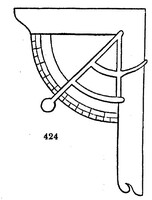1781. For taking the height of a tree. Rods of deal or bamboo, seven feet long, made so as to fit into ferrules at the end of each other, tapering as in a fishing-rod, may be used. Five of them with feet marked on them would enable a man quickly to measure the height of a trunk of not more than forty feet, as he would reach above seven feet. Fig. 422. shows a measuring-staff for taking the height of trees. To form this, divide a square staff (a b, fig. 422.) of about seven or eight feet in length into feet and inches, for the convenience of measuring the distance between the place of observation and the tree, or taking any other dimensions. Upon one side of this staff, at a commodious distance from the bottom, fix a rectangular board (c d e f) whose length (d e) is exactly equal to twice its breadth (c d), which breadth may be about four or five inches. At c and d fix sights, or small iron pins, and also at g and e, making d g and g e each equal to c d. Then, when the top of a tree is seen through the sights at c and g, the tree's height is equal to your distance from its bottom added to the height of your eye; but if seen through the sights at c and e, its height is equal to twice your distance from its bottom, adding the same height as before. In making an observation with this instrument, it ought to be fixed perpendicularly to the horizon, which may be done by means of a plummet suspended from n. In taking the altitude of a tree growing upon an inclined plane, you must endeavour to make your observations from a place upon a level with the bottom of the tree. If this cannot be done, direct the horizontal sights at c and d towards the lower part of the tree, and let your assistant make a mark upon it; then find the height of the tree above this mark, as before, to which add the distance of the mark from the ground, which must, in this case, be considered the height of the eye, and the sum will be the height of the tree. (J. B. W. in Gard. Mag. vol. xvii. p. 350.) Another mode of taking the height of trees is by means of the instrument fig. 423. This machine consists of a thin board of oak, two feet nine inches long, shaped like a gun-stock, the end (a) being adapted for the shoulder, the muzzle or line (b c) for taking a sight of the top of the tree, and the square, of which c d is a side, being marked or cut on the board at the farther extremity. The length of the side of the square is four inches. A diagonal line is drawn across from the angle c; and parallel to this line, a brass pendulum is suspended from a side pin. This pendulum has a curved limb or finger (e) attached any where near its middle; and the pendulum and curved limb are kept from flying off the board by two brass guards, which, however, admit of the free action both of the pendulum and curved limb. At the extremity of the muzzle (c), a sight is fixed, as in the barrel of a common fowling-piece, to guide the eye; and the but-end of the instrument being applied to the shoulder, and the sight on the end of the barrel part directed to the top of the tree, the operator advances towards it or retires backwards, till the point of the curved limb is visible above the line of the stock, as in the figure. The circumstance of the curved limb being visible above the barrel part of the instrument proves to the operator that the plumb line rests on the diagonal line of the square, and consequently that the angle made by the eye of the operator with the top of the tree is 45ᆭ. The distance of the operator from the tree, and the height of his eye from the ground, being then added together, give the height of the tree, unless the ground should not be level; in which case allowance must be made, either by adding or subtracting, according as the ground may be lower where the operator stands than at the root of the tree, or the contrary. This instrument was invented by Mr. Cuthbertson, the head gardener at Studley Royal; and fig. 424. shows a modification of it invented by the late Mr. Jukes, of much smaller size, as it is only twelve inches long on the upper side. It is made of box with a brass octant suspended from its centre, with a curved limb, and loaded at the extremity. It is used in the same manner as the instrument shown in fig. 423. It will be observed, however, that this instrument can only be used where trees stand singly; where they are crowded together, the rods of deal or bamboo already mentioned are by far the best. To use them, a rod is pushed up the side of the trunk, and then a piece of tin tube, about four inches in length, and of the same diameter in the clear as the rod, is fixed on the lower end of it about two inches; another rod is then inserted in the other end of the tube, and pushed up; and so on till the jointed rod is made to reach to the top of the tree.





